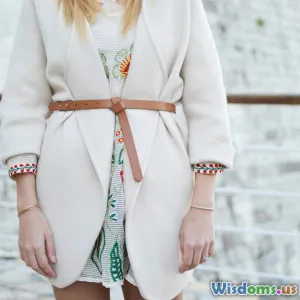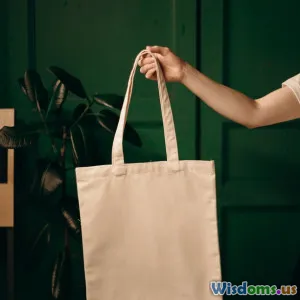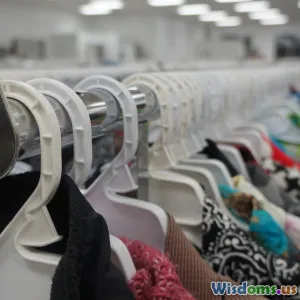
Can Thrifting Replace Mall Shopping Pros and Cons Analyzed
7 min read Explore the pros and cons of thrifting versus mall shopping to see if secondhand can truly replace modern retail. (0 Reviews)
Can Thrifting Replace Mall Shopping? Pros and Cons Analyzed
In the age of fast fashion and increasing environmental awareness, the question arises: can thrifting replace traditional mall shopping? For many fashion enthusiasts and budget-conscious shoppers, thrifting offers a unique allure—distinctive pieces, eco-friendliness, and budget benefits. Yet, mall shopping remains a stronghold for the convenience, variety, and freshness it provides. This article dives deeply into the pros and cons of each, offering actionable insights to help you decide where your next fashion haul should come from.
Understanding the Landscape: Thrifting and Mall Shopping
What Is Thrifting?
Thrifting involves buying secondhand clothing and accessories, usually at thrift stores, consignment shops, or online resale platforms like Depop and Poshmark. Unlike vintage collecting, thrifting generally focuses on affordable, often gently-used items with personal and ecological value.
What Is Mall Shopping?
Mall shopping represents the traditional retail environment: new clothing, a wide variety of brands, up-to-date trends, and often the immediate gratification of take-home-ready purchases.
The Pros of Thrifting
1. Sustainable Fashion Choice
Clothing production is responsible for approximately 10% of global carbon emissions and heavy water usage. Thrifting reduces demand for new garments, lessening environmental impact. According to a 2023 ThredUp report, buying secondhand extends the life of every item and significantly cuts carbon footprints, contributing to conserving our planet.
2. Unique and Vintage Finds
Thrifting unlocks fashion treasures that malls rarely offer. Those vivid ‘80s jackets or rare band tees can create a style narrative that stands out. For example, actress Emma Watson often advocates for secondhand fashion to emphasize personal style over fast trends.
3. Cost-Effectiveness
Secondhand items typically cost 50-90% less than retail prices. Shoppers on a budget or those who enjoy frequent wardrobe rotations find thrifting appealing. This can allow experimentation with new styles without breaking the bank.
4. Vibrant Shopping Experience
Hunting through racks or browsing curated online resale platforms can be thrilling—akin to a fashion treasure hunt. It fosters patience, mindfulness, and creativity.
The Cons of Thrifting
1. Limited Sizes and Availability
Thrift stores don’t guarantee every size or style is in stock, which is frustrating for shoppers with specific needs. A 2022 consumer survey found 30% of people stopped thrifting due to inconsistent availability.
2. Time-Consuming Process
Sorting through racks or scrolling online resale requires more time and effort than the streamlined mall shopping experience.
3. Variable Quality and Condition
Items may show wear, stains, or outdated fashion. While a savvy buyer can repurpose or upcycle, this is not always appealing or feasible.
The Pros of Mall Shopping
1. Convenience and Accessibility
Malls provide easy access to multiple brands in one location, instant fitting room availability, and hassle-free returns.
2. Trend-Forward and New Items
You get the latest styles, full-size ranges, and the assurance that products are pristine and under warranty.
3. Brand Loyalty and Experience
Some shoppers enjoy brand-specific experiences, loyalty programs, and the curated ambiance of retail spaces.
The Cons of Mall Shopping
1. Environmental Impact
Fast fashion and frequent purchases contribute significantly to waste and pollution. The Ellen MacArthur Foundation reports over 92 million tons of textile waste annually, much coming from new clothing purchases.
2. Cost and Impulse Buying
New items often come at premium prices, promoting overconsumption. Mall atmospheres trigger impulse buys, increasing financial and environmental costs.
3. Homogeneous Style
Malls typically offer standardized styles which can limit individual expression in favor of broad appeal.
Real-World Insights
A 2024 Nielsen report on shopping habits reveals 48% of millennials and Gen Z shoppers purchased secondhand items, citing environmental concerns and cost savings. However, 62% continue to shop malls for brand-new trends and convenience.
Fashion icon/activist Lilly Singh highlights thrifting as a "way to make bold style statements authentically while caring for the planet." Conversely, many consumers emphasize that mall shopping remains their go-to during time-sensitive fashion needs or specific size requirements.
Conclusion: Is Thrifting Ready to Replace Mall Shopping?
Thrifting and mall shopping each serve distinct needs and preferences. Thrifting champions sustainability, unique style, affordability, and fun but demands patience and flexibility. Mall shopping offers immediacy, variety, and assured quality at a higher environmental cost.
A synthesis approach may be ideal: integrating thrifting into your shopping habits can reduce environmental footprint and budget strain while keeping mall trips for necessary or specific purchases.
Making informed choices encourages a more conscious and personally rewarding style journey. Whether you embrace thrifting as a primary means or a complementary practice to traditional retail, the shift towards thoughtful consumerism reshapes the future of fashion.
By conscious consideration, you empower your wardrobe and the environment.
References
- ThredUp 2023 Resale Report
- Ellen MacArthur Foundation: Fashion Waste Data, 2023
- Nielsen Consumer Shopping Trends, 2024
- Quotes from public interviews with Emma Watson and Lilly Singh
Rate the Post
User Reviews
Popular Posts





















